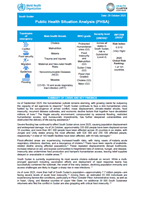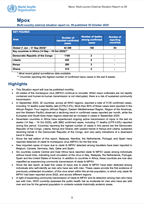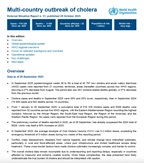
Emergency news
All →Our emergency work in focus
All →
Publications
All →National health emergency alert and response framework
This multi-hazard Health Emergency Alert and Response Framework provides guidance for coordinating emergency response in countries, under the global Health...
Therapeutics and COVID-19: living guideline, August 2025
The WHO Therapeutics and COVID-19: living guideline contains recommendations for the use of therapeutics in the treatment of COVID-19. It is...
The COVID-19 Clinical management: living guidance contains the most up-to-date WHO recommendations for the clinical management of people with COVID-19....
NAPHS for all: a country implementation guide for national action plan for health security (NAPHS)
A national action plan for health security (NAPHS) is a country-owned, multi-year, joint planning process that can improve the implementation of IHR core...
Documents
All →
Public Health Situation Analysis - South Sudan
As of September 2025, the humanitarian outlook remains alarming, with growing needs far outpacing the capacity of aid agencies to respond. South Sudan...

This is the 59th situation report for the multi-country outbreak of mpox, which provides details on the global epidemiological situation for mpox, including...

From 1 January to 28 September 2025, a cumulative total of 518 324 cholera cases and 6508 deaths were reported from 32 countries across five WHO regions,...

Joint FAO/WHO/WOAH Rapid Risk Assessment of Rift Valley fever (RVF) in Senegal and Mauritania: Implications...
This Joint FAO/WHO/WOAH Rapid Risk Assessment (RRA) aims to assess the risk of Rift Valley fever (RVF) at the global, regional, and national level, considering...
More about our work in emergencies

Tracking SARS-CoV-2 variants
Overview
All viruses, including SARS-CoV-2, the virus that causes COVID-19, change over time. Most changes have little to no impact on the virus’s properties. However, some changes may affect the virus’s properties, such as how easily it spreads, the associated disease severity, or the performance of vaccines, therapeutic medicines, diagnostic tools, or other public health and social measures.
In June 2020, the WHO Virus Evolution Working Group was established with a specific focus on SARS-CoV-2 variants, their phenotype and their impact on countermeasures. This later became the Technical Advisory Group on SARS-CoV-2 Virus Evolution. In late 2020, the emergence of variants that posed an increased risk to global public health prompted WHO to characterize some as variants of interest (VOIs) and variants of concern (VOCs) in order to prioritize global monitoring and research, and to inform and adjust the COVID-19 response. From May 2021 onwards, WHO began assigning simple, easy-to-say labels for key variants.
Considerable progress has been made in establishing and strengthening a global system to detect signals of potential VOIs or VOCs and rapidly assess the risk posed by SARS-CoV-2 variants to public health. More specifically, in 2024 WHO launched a WHO Coronavirus Network (CoViNet) to facilitate early and accurate detection of coronaviruses and variant tracking including coordinating risk evaluations. It remains critical that these systems are maintained, and data are shared, according to good principles and in a timely fashion, as SARS-CoV-2 continues to circulate at high levels around the world. While monitoring the circulation of SARS-CoV-2 globally, it also remains essential to monitor their spread in animal populations and chronically infected individuals, which are crucial aspects of the global strategy to reduce the occurrence of mutations that have negative public health implications. In March 2023, WHO updated its tracking system and working definitions for variants of concern, variants of interest and variants under monitoring. They can be found here. The previous working definitions can be found here.


